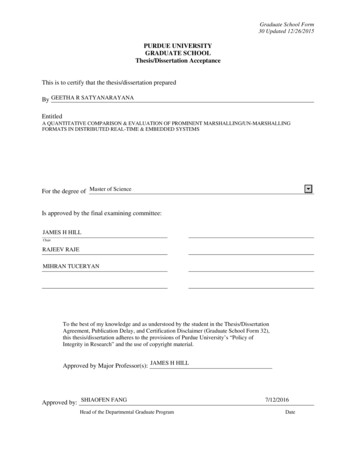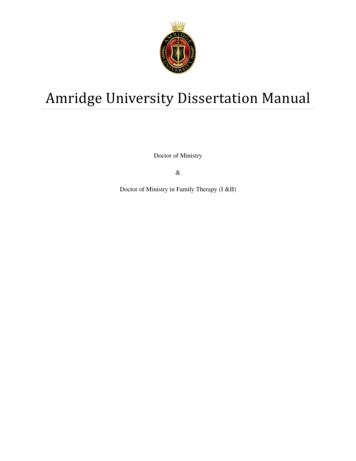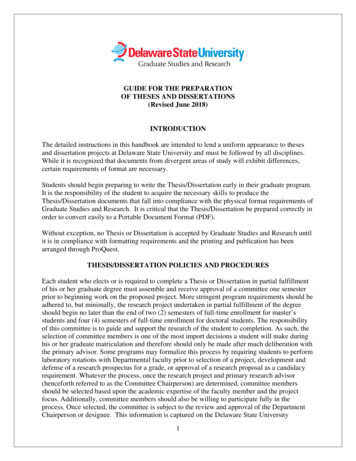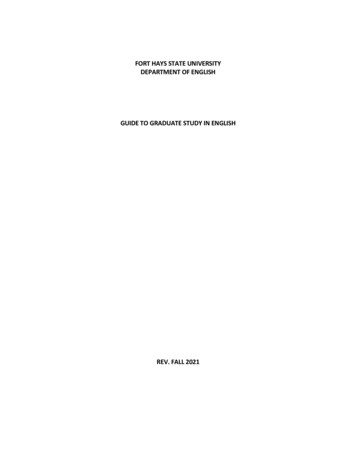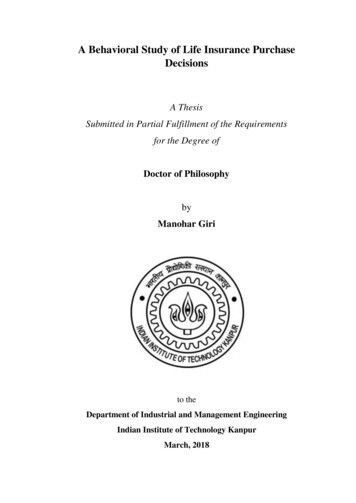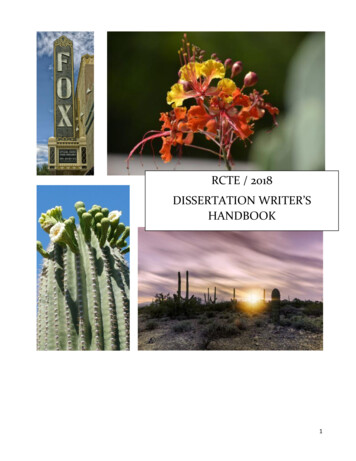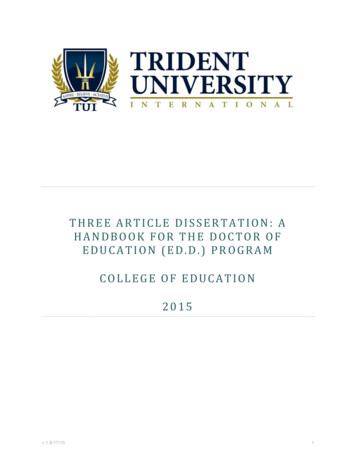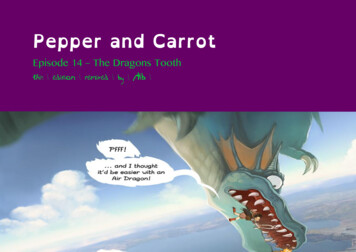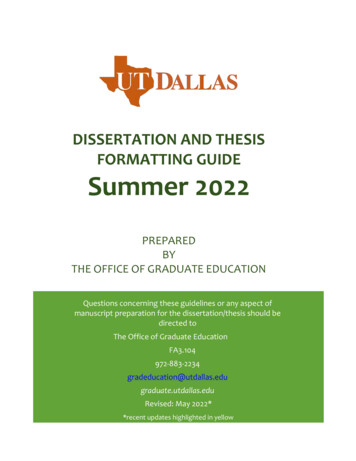
Transcription
DISSERTATION AND THESISFORMATTING GUIDESummer 2022PREPAREDBYTHE OFFICE OF GRADUATE EDUCATIONQuestions concerning these guidelines or any aspect ofmanuscript preparation for the dissertation/thesis should bedirected toThe Office of Graduate .edugraduate.utdallas.eduRevised: May 2022**recent updates highlighted in yellow
TABLE OF CONTENTSFORMATTING GUIDE. 3STYLE GUIDE OPTIONS . 4CONTENT OVERVIEW OF THE DISSERTATION/THESIS . 5CONTENT DESCRIPTION OF THE DISSERTATION/THESIS . 6FORMATTING GUIDELINES . 8DISSERTATION/THESIS CONTENTS . 8CONSISTENCY . 8LANGUAGE . 8PAGE SIZE AND PAPER SPECIFICATION . 8MARGINS . 8FONT. 9SPACING . 9TABLES & FIGURES . 10HEADINGS & PAGE NUMBERS . 11USE OF PREVIOUSLY PUBLISHED PAPER(S) WITHIN A DISSERTATION/THESIS . 112 Page
This guide is designed to assist students in preparation of their dissertation/thesis and tohelp graduate candidates present results of their research for the use and interest of theacademic community and the public at large. Submission of the dissertation/thesis is thefinal step leading to conferral of a graduate master’s or doctoral degree. UT Dallas requirespublication of the dissertation and abstract in its original form. The dissertation becomes apermanent and archived record of original research. General guidelines outlined in this guideapply to both master’s and doctoral students unless otherwise specified. At UT Dallas, theterm dissertation refers to the final research paper for the doctoral degree and the termthesis refers to the research paper required for some master’s programs. Please refer to theDISSERTATION AND THESIS SUBMISSION GUIDE for information and requirements forsubmission. University policies on graduate study at UT Dallas are outlined in the PolicyStatement UTDPP1052, https://policy.utdallas.edu/pdf/utdpp1052.Please note that the student is responsible for knowing and conforming to the currentguidelines and to any special departmental or disciplinary requirements that may apply.Difficulty of use or lack of knowledge of software tools will not be considered reasons toexempt an author from compliance with these guidelines.It is the responsibility of the author to reformat the document into a PDF file, check thereformatted document for accuracy, and submit the PDF document to the UTD ETD websitefor publication. No compression should be used. No changes can be made to the electronicthesis/dissertation once it is approved.3 PageFORMATTING GUIDEFORMATTING GUIDE
Various disciplines use different conventions in writing and publishing. Therefore, graduatecandidates, in consultation with their dissertation advisor and committee, may select from aset of recognized style manuals. All decisions regarding style and format must be consistentwith the chosen style manual and the guidelines outlined in this Dissertation and ThesisGuide. In addition to the recommendations of each style guide, the Office of GraduateEducation has a small number of required format elements which are outlined in theremainder of this guide.Reference guidelines and appropriate citation standards should reflect the author’s styleguide choice and discipline. They must be detailed consistently throughout the document.Reference format should be consistent with discipline and publication standards and/or styleguide choice.Recommended style guides are listed below: Banik, Baysinger, Kamat & Pienta. ACS Guide to Scholarly Communication. (4thedition). An American Chemical Society Publication.Access has moved to an online version available to ACS Members andorganizational subscribers and will be updated digitally(https://pubs.acs.org/page/acsguide). Either the book or online version areacceptable. American Psychological Association. Publication Manual of the AmericanPsychological Association (7th Edition). Washington, D.C.: American PsychologicalAssociation. The Chicago Manual of Style (17th edition). Chicago: University of Chicago Press. IEEE Editorial Style Manual, org/conferences/style references manual.pdf Modern Language Association of America. MLA Handbook (9th Edition). New York:Modern Language Association of America. Turabian, Kate L. A Manual for Writers of Term Papers, Theses, and Dissertations (9thEdition). Chicago: University of Chicago Press.4 PageSTYLE GUIDE OPTIONSSTYLE GUIDE OPTIONS
CONTENT OVERVIEW OF THE DISSERTATION/THESISThe table below displays the recommended contents, document order and page numbers for thedissertation/thesis. Not all documents contain all items; however, if they are included, they must be in thisorder.First Page (formerly Signature Page)Page counted, number is not typed orprinted on pageCopyright Page (optional, but inclusion is highlyrecommended)Page counted, number is not typed orprinted on pageDedication (optional)Page counted, number is not typed orprinted on pageTitle Page (required)Page counted, number is not typed orprinted on pageAcknowledgments (required)Counted, number typedAcknowledgments is the first page onwhich a number will appearCounted, number typedAbstract (required)ProQuest/UMI permits 500 words for both doctoral andmaster’s abstractsTable of Contents (required)Counted, number typedList of Figures or List of Illustrations (required if there are 5or more figures)If included, type number(s) on page(s)List of Tables (required if there are 5 or more tables)Counted, number typedList of abbreviations or symbols (if used)Counted, number typedBody of Dissertation (required)a. Text (required)b. Appendix/Appendices (optional)c. Bibliography, References or Works Cited (required)First page of text is always numbered “1”.Remaining pages are numberedconsecutively in Arabic numeralsBiographical Sketch (required)Counted, number typedCurriculum Vitae (required)Pages not counted as part of main text,numbering optional5 PageCONTENT OVERVIEW OF THEDISSERTATION/THESISOur office will not accept dissertation submissions that are missing major components. All headings mustbe set up, all chapters must be complete, all figures/tables must be incorporated into the body of thedissertation or placed in appendices, and there can be no placeholders for major sections. The versionsubmitted to our office is the version that you will defend with, and as such, it must be as complete aspossible. The only sections that can be added later are the Dedication, Acknowledgments, BiographicalSketch and Curriculum Vitae.SectionNumbering & PaginationPreliminary Pages
CONTENT DESCRIPTION OF THE DISSERTATION/THESISFirst PagePreviously called the Signature Page, this page contains the committee members’ names inalphabetical order by last name unless there is a reason to do otherwise. This page isunsigned in the electronic version of the thesis/dissertation.CopyrightThe author of the thesis/dissertation automatically owns the copyright of his or her originalwork once it is “fixed” in some medium - written on paper, stored on a computer drive, etc.It is not required to place a copyright notice on page 2 of the thesis/dissertation, but it ishighly recommended. If the notice is included, the student’s name must be identical to thename on file in the Registrar’s Office and as it appears on the first page, title page and theabstract. For further information about copyright protection, ownership and fair rights, seehttp://www.copyright.gov/.The student’s name must appear here as it does on the first page, copyright page and on theabstract. The date on this page is the date of the conferral of the degree, not the date of thedefense of the thesis/dissertation.If the thesis or dissertation has a main title and a subtitle, put the main title on a single line,followed by a colon, and organize the subtitle in inverted pyramid form below the main title.If the main title is too long to fit on a single line, organize the main title in inverted pyramidform.AcknowledgmentsAt the end of the acknowledgments page, leave two single line spaces below the last line oftext and add the “Month Year” in which you defended your thesis or dissertation.6 PageCONTENT DESCRIPTION OFTHE DISSERTATION/THESISTitle Page
AppendicesMaterials which are peripheral but relevant to the main text of the thesis/dissertation shouldbe placed in appendices. Appendix material must meet the same requirements of marginsand pagination as the text. Reduction of materials to meet margin requirements isacceptable only if the print remains clear and legible.Documentation SourcesReference guidelines and appropriate citation standards should reflect the author’s styleguide choice and discipline. They must be detailed consistently throughout the document.The bibliography or list of references should indicate materials actually used (and theedition, if that used is not the first). Reference format should be consistent with disciplineand publication standards and/or style guide choice.Biographical Sketch and Curriculum VitaeA brief biographical sketch of the author should be included and written in third person.Information may include education and degrees awarded, publications, and any teaching,business, industry, or military experience. The Curriculum Vitae (CV) should be consistentwith discipline standards. For examples and information see Sample Pages on the Office ofGraduate Education website.Non-Print Dissertations/ThesesSpecific format requirements for videotapes, paintings, and so forth should be obtainedfrom The Office of Graduate Education prior to the start of the creative project.7 PageCONTENT DESCRIPTION OFTHE DISSERTATION/THESISTable of ContentsThe Table of Contents is required. The Table of Contents should accurately reflect theoutline and organization of the manuscript. It should include the Acknowledgments,Abstract, List of Figures (if any), List of Tables (if any), List of Abbreviations (if any), chaptertitles of the text (and any sections/subsections you choose to include), Appendices (if any),Bibliography/References, Biographical Sketch, and Curriculum Vitae (the Curriculum Vitae islisted in the Table of Contents but is not assigned a page number).ATION/THESISAbstractThe abstract should be a concise statement of the nature and content of thethesis/dissertation, indicating its significance as a piece of research. It should be acontinuous summary, not disconnected notes or an outline. Both doctoral dissertation andmaster’s thesis abstracts should not exceed 500 words. Even though ProQuest/UMI nolonger has a word limit on abstracts, they will truncate any abstract over 500 words whenthey publish it in print indexes such as “Dissertation Abstracts International” and “Master’sAbstracts International”. The candidate must make certain that the name appearing on theabstract is the same as that on the first, copyright, and title pages. The title of the abstractmust be the same as the title on the finished dissertation. The year on this page is the year ofdegree conferral.
FORMATTING GUIDELINESThe Office of Graduate Education has prepared the following suggestions to assist withdissertation/thesis preparation. The requirements for formatting, production and submission ofdissertation/thesis outlined below meet the necessary standards for electronic archiving as set out in theProQuest/UMI and American Library Association (ALA) guidelines. The precise form, style and appearanceshould be consistent throughout and conform to best practices in the discipline and those outlined in theselected style guide. The finished dissertation/thesis reflects the ability and character of its author andmust be a professional quality manuscript. To help prepare for writing of the manuscript and to assistwith formatting and style decisions, see our Sample Pages. Also, completed dissertations are available forreview in the Dean’s Office of each school, in the Eugene McDermott Library and also onlineelectronically. Examples of preliminary pages are available as downloadable templates in two formats Microsoft word and LaTeX.Download MS Word templateDownload LaTeX TemplateDissertations submitted to our office must be formatted using our most recent template. Dissertationsformatted without a template or with an outdated template (Feb. 2018 or earlier for Word, Oct. 2021 orearlier for LaTeX) will be rejected and students will be asked to resubmit.DISSERTATION/THESIS CONTENTSThe dissertation/thesis represents an organized, cohesive document of original scholarlyresearch. Content will always include a descriptive title and subtitles. It must also include anabstract, a full introduction delineating a research question, a comprehensive literaturereview, and a final overall discussion describing the results of the research and thecontribution of the dissertation/thesis to the field.CONSISTENCYAs a representative document, the dissertation and thesis should be produced in a formatwith a consistent style and appearance. Consistency extends to pagination, font, tablepresentation, etc. Refer to selected style guide for recommendations.LANGUAGEThe document should be written in Standard English and adhere to appropriate spelling,grammar, and punctuation conventions.PAGE SIZE AND PAPER SPECIFICATIONPage size must be 8.5 x 11 inches (or 216 279 millimeters), also known as “letter” size inU.S. standards. All top margins- 1.25”All left margins- 1.25”All right margins- .75”All bottom margins- 1.25”Margins must be consistent throughout the manuscript, including pages containing tables,figures, or other illustrative materials.8 PageFORMATTINGGUIDELINESMARGINS
FONT 12-point font is standard and recommended for legibilityFont size should remain consistent throughout. Within the document, keep allfigure/table captions and chapter headings the same font size as the text Smaller font size may be appropriate for footnotes or other material outside of themain textSPACINGThe document must be either double-spaced or spaced with 1.5 spaces, throughout.Exceptions to this may include the following: Bibliography should be single spaced within each entry while maintaining a doublespace between each entry - this convention also holds true for Table of Contentsentries, List of Tables/Figures entries, and Table/Figure captions that are more thanone line in length Quotations as paragraphs, captions, lists, graphs, charts, footnotes/endnotes,bibliographic entries, items within tables, and lists in appendices Lengthy tables may be single-spaced Irregular spacing may be used to accommodate poetry, creative writing or otherforms of artistic expressionAvoid: Widows - a short line ending a paragraph at the top of a page Orphans - a heading or subheading at the bottom of a page that is not followed bytext White Space - When a figure or table won’t fit on a page and you move it to the topof the next page, sometimes blank space or “white space” is left on the firstpage—this is unacceptable. Please continue text from the second page to fill upthe blank space on the first page Conversion errors - If you are working in Microsoft Word, please make all edits in yourWord file and convert the file to PDF once edits have been made. Our office cannot makechanges to a document that has been converted from PDF to Word. All track changes mustbe turned off before converting to PDF.A word of caution: DO NOT use another thesis/dissertation as a model for your work without alsochecking the current guides. Do not assume that because another thesis/dissertation was acceptedwith the same format, yours will be. A number of situations could arise: requirements orinterpretations may have changed; an inexperienced checker may have let faulty formatting slip by,etc. When in doubt, check with the Office of Graduate Education. Theses/dissertations that differsignificantly from the requirements outlined in these guidelines will not be accepted.9 Page
The caption must be placed above a table, but below a figure. A List of Figures and a List ofTables should be placed after the Table of Contents if there are 5 or more figures and/ortables in your dissertation/thesis. Also, figures/tables should appear within the text as closeto the reference as possible.There are a few different options on how to incorporate figures within thedissertation/thesis. Please do not list figures/tables at the end of a chapter. We ask thatfigures/tables either be integrated into the text, moved to an Appendix, or uploaded asSupplemental Files. Each option is explained below.If the information is pertinent to the surrounding text, it may make sense to integrate thefigures/tables into the text of the chapters. This is very common for smaller figures/tables,but can apply to larger figures/tables as well. If some of these figures/tables are moresupplemental to the dissertation/thesis content, there are a few additionaloptions. Figures/tables can be moved into Appendices after the final chapter of thedissertation/thesis, directly before the References. These sections have headings in thesame format as the chapters, for example:APPENDIX ASUPPLEMENTAL FIGURES FOR CHAPTER 3Alternatively, figures, tables or data sets that should be included with the dissertation/thesismaterial but don’t necessarily need to appear within the dissertation/thesis itself can beuploaded as Supplemental Files. These will be published with your dissertation/thesis online,but not as a section within the dissertation/thesis. Please note that Supplemental Files willappear within UTD’s digital repository, Treasures @ UT Dallas, but cannot be published toProQuest UMI.10 P a g eFORMATTINGGUIDELINESTABLES & FIGURESTables and figures may be numbered in one of two ways: 1) consecutively throughout thedocument (e.g. Table 1 – Table 10), or 2) double-numbered so that the table or figures’numbers reflect their locations in the document (Figure 2.3 is the third figure in Chapter 2, orFigure A.2 is the second figure in Appendix A). For consistency, do not mix these two typesof numbering schemes within your dissertation or thesis.
HEADINGS & PAGE NUMBERSChapter headings should be centered, bold, in all caps, and 1.25” from the top of the page.NOTE: Page 1 is the first time any text can appear in bold face type—do not bold text withinthe preliminary pages.(line 1) CHAPTER X(line 2- leave one single line space)(line 3) CHAPTER TITLE(line 4- leave one single line space)(line 5- leave one single line space)(line 6) Begin text on this line, against the left marginUSE OF PREVIOUSLY PUBLISHED PAPER(S) WITHIN A DISSERTATION/THESISAt the discretion of the advisor and program, the graduate candidate has the option toinclude as part of the dissertation or thesis, the text of an original paper or papers that havebeen or will be submitted to journals in the field. The inclusion of manuscripts co-authoredby the candidate is acceptable. Where the student is not the sole author of a manuscript,the introductory material to the chapter must explicitly describe the student’s contributionto the work and acknowledge the contributions of the other author(s) of the work.Contents The manuscript thesis or dissertation must be more than a mere collection ofmanuscripts published or to be published. It must include a comprehensive abstract,a full introduction and literature review, and a final overall conclusion whichinterprets the results of the research and describes the contribution to the field. On the first page of the chapter based on a previous publication, a footnote must beincluded which acknowledges or gives credit to the previous publication. Also, use ofa separate chapter title page, with authors and their affiliations listed, may beappropriate (see Sample Pages). In addition, the styles used in manuscripts previously published or submitted forpublication may follow the styles required by the journals. The pagination of thepages, however, must follow the guidelines for the traditional thesis/dissertation asoutlined in this guide. The preliminary pages are the same as for the traditionalthesis/dissertation.11 P a g eFORMATTINGGUIDELINESLowercase Roman numerals, centered .75” from the bottom of the page, should be used tonumber preliminary pages, beginning with the preface and/or acknowledgments (seetemplate for examples).Arabic numerals, beginning with “1” are used to number all pages of the body of thedissertation/thesis. All page numbers should be centered, .75” from the bottom of the page.
The figures/tables should appear within the text as close to the reference of thefigure/table as possible. If it is absolutely necessary not to include figures/tableswithin the text, they should be grouped in an appendix.References References can either be listed chapter-by-chapter, or be presented in a single list atthe end of the thesis/dissertation. If the chapter-by-chapter approach is used, eachchapter, including chapters that are not manuscripts (such as the introduction andconcluding chapters), requires a list of references.Each separate chapter may be set up with the following elements: Title page List of Tables (if any) List of Figures (if any) Sections within each chapter may include:1. Acknowledgments (may be included with chapters or at the beginning of theentire paper)2. Abstract3. Introduction4. Materials and Methods5. Results6. Discussion7. ReferencesUse of Previously Published Papers within a Dissertation/Thesis Because many papers will have already been published by the time final dissertationsare submitted, the candidate should be careful to refer to page 11 in the SubmissionGuide (“USE OF COPYRIGHTED MATERIAL”)12 P a g e
apply to both master's and doctoral students unless otherwise specified. At UT Dallas, the term dissertation refers to the final research paper for the doctoral degree and the term thesis refers to the research paper required for some master's programs. Please refer to the
